The wildlife of Florida includes a beautiful array of animals. As a former wildlife biologist that was born and raised in Florida, I have a special appreciation for the creatures that call the Sunshine State home.
At the last official count, there are over 4,000 animal species in the state. While this article won’t cover every single species in the state, I will share 25+ of the most iconic animals that live in the state.
Key points:
- The state of Florida is home to over 4,000 animal species.
- 269 species that live in Florida are endemic, which means they don’t live anywhere else.
- Florida is the seventh-most biodiverse state in the nation.
Wildlife of Florida: A Highlight Reel
It would take me an entire book to share all of the wonderful critters of Florida. But since this isn’t a book, I will share 25 of the most iconic animals that live in the state.
American Alligator
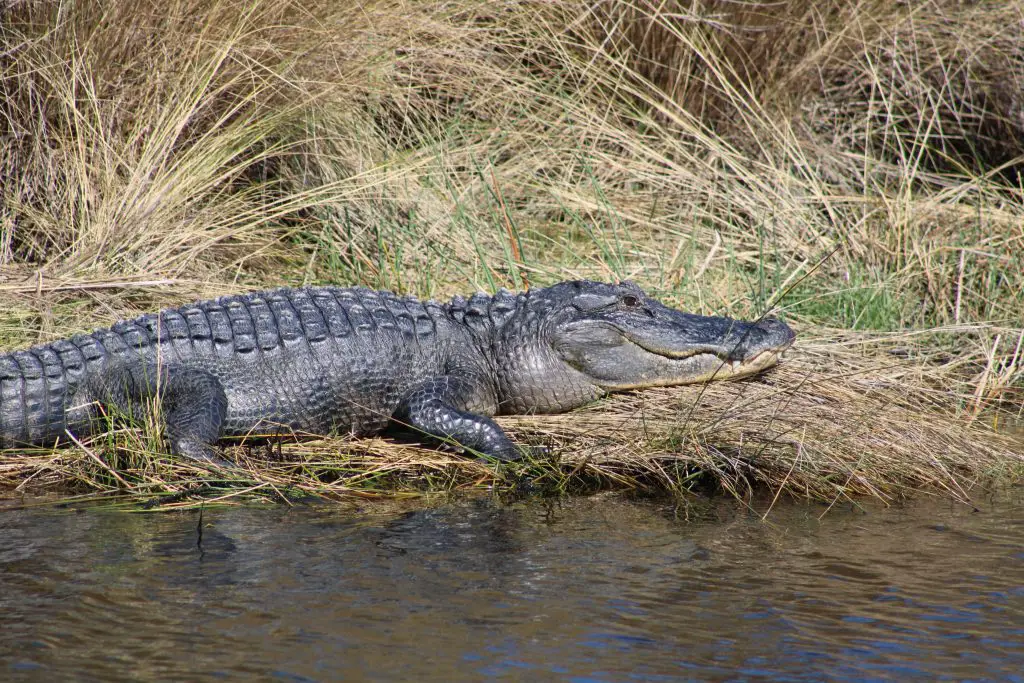
I can’t start this list of wildlife of Florida with anything other than the American Alligator.
The American Alligator (Alligator mississippiensis), Florida’s iconic reptilian inhabitant, stands as a living testament to the state’s unique wildlife. These formidable creatures possess an unmistakable appearance, with sturdy bodies covered in dark, rough, armored scales. The American Alligator’s defining feature is its broad, U-shaped snout, which distinguishes it from its narrower-snouted cousin, the American Crocodile.
Thriving in Florida’s diverse wetland ecosystems, American Alligators have developed several remarkable adaptations. Their eyes and nostrils are strategically placed atop their heads, allowing them to lurk stealthily in the water while remaining nearly submerged, awaiting prey. Meanwhile, their powerful tails enable swift underwater propulsion and navigation. To witness these awe-inspiring creatures in their natural habitat, head to Florida’s numerous wetlands, swamps, and wildlife sanctuaries, including the Everglades National Park.
Despite being taken off the Endangered Species List in 1987, American Alligators are still protected under federal law, and their conservation status is considered “Least Concern” thanks to dedicated efforts to safeguard their habitats and regulate hunting.
Florida Key Deer
The key deer (Odocoileus virginianus clavium), a subspecies of the white-tailed deer, is a diminutive resident of the Florida Keys. Standing just 2.5 to 3 feet tall at the shoulder, these deer are distinguished by their reddish-brown fur and a small, rounded tail. Despite their petite size, Key Deer are renowned for their persistent presence in the tough ecosystems of the Florida Keys.
Survival in the Florida Keys has driven the Key Deer to develop remarkable adaptations. Their reduced size aids them in navigating the challenging terrain of these islands, while their diet primarily consists of vegetation found in this subtropical region, including native plants like thatch palm berries. They’ve also honed their swimming abilities, an essential skill given the prevalence of water in their environment.
To catch a glimpse of these charismatic creatures, you’ll want to head to their primary habitat, the Big Pine Key and No Name Key regions. While driving cautiously along the designated roads and adhering to posted speed limits, you may encounter them grazing or traversing through the brush. It’s a rare sight to add to your wildlife of Florida checklist.
Osprey
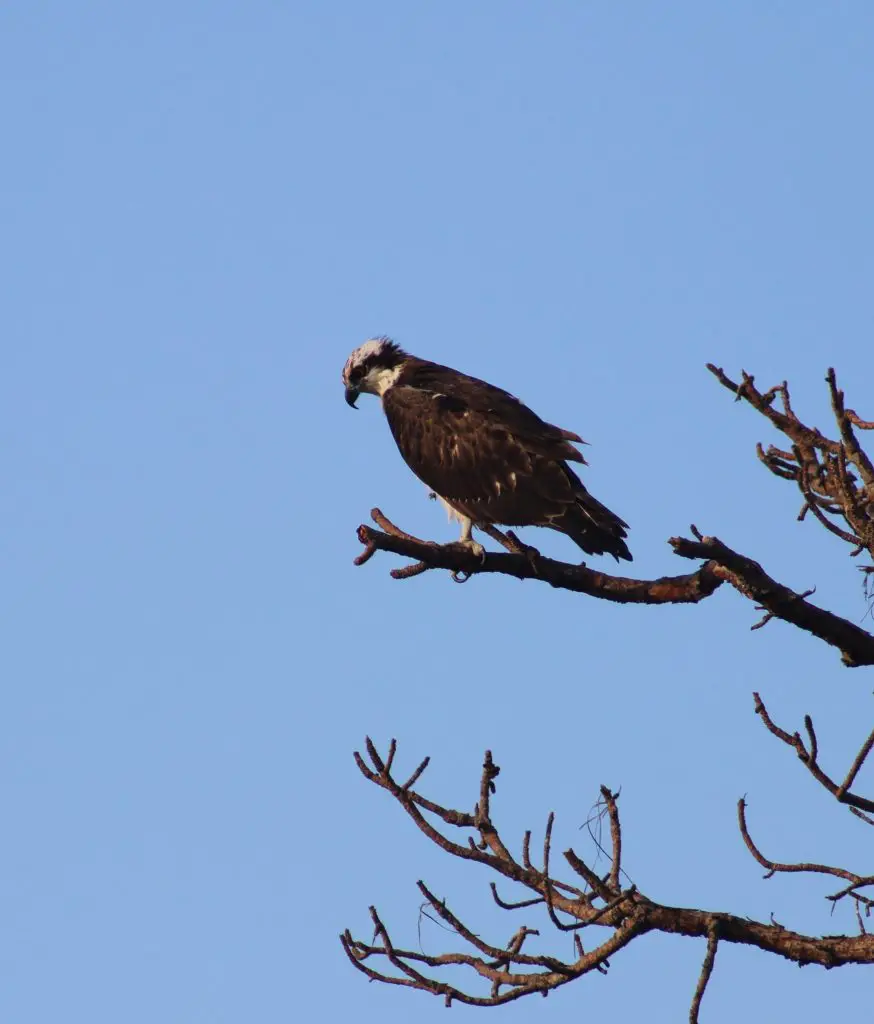
The osprey (aka the fish eagle) is a raptor that frequents Florida’s coastal and wetland regions. With a wingspan of up to six feet, they are easily recognizable by their striking appearance. Ospreys showcase a sharp contrast of white heads and underparts against dark brown wings and backs, making them a prominent sight in the Florida skies.
These raptors are expert anglers, capable of diving at high speeds to snatch their prey. Their keen vision helps them spot fish from great heights, further enhancing their hunting prowess.
Florida offers numerous opportunities to observe Ospreys in action. Coastal areas, lakeshores, and riversides are prime locations to witness their spectacular hunting flights and nest-building activities. They often construct their nests on man-made structures like utility poles and channel markers.
Osprey so encapsulates the wildlife of Florida that, at one point, there was a petition to make this the state bird.
Manatee
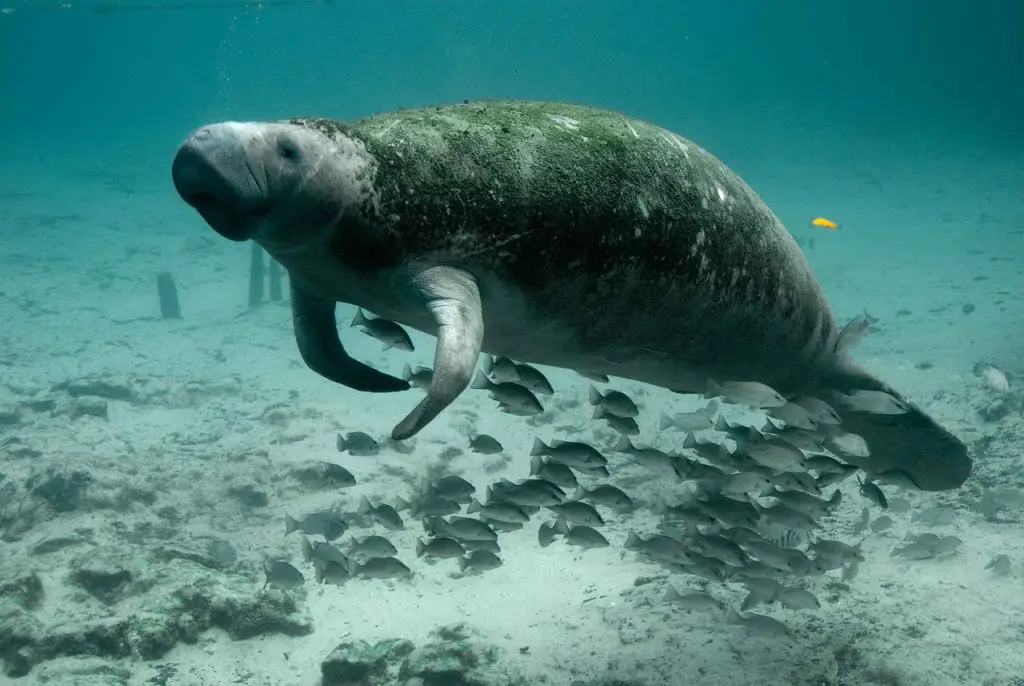
Manatees are endearing aquatic giants that grace the waters of Florida. These gentle, slow-moving mammals boast a rotund, blubbery body, typically grayish-brown in color, with wrinkled, whisker-covered faces. Their large, paddle-like flippers and flat tails are perfectly designed for life in the water.
Manatees have several key adaptations that aid their survival in Florida’s warm coastal waters. Their immense size helps them store energy and maintain body temperature in chilly winter months. Additionally, their streamlined bodies are ideal for efficient swimming and grazing on seagrass, their primary food source.
You can often spot these gentle giants in the state’s springs, rivers, and coastal areas, especially during the winter months when they seek out warmer waters. Some popular locations for Manatee encounters include Crystal River, Homosassa Springs, and Blue Spring State Park.
Despite conservation efforts, manatees remain classified as “Vulnerable” due to ongoing threats such as boat strikes and habitat degradation. Protecting these charismatic creatures and their habitats is essential to ensure their long-term survival as wildlife in Florida waters.
Bottlenose Dolphin
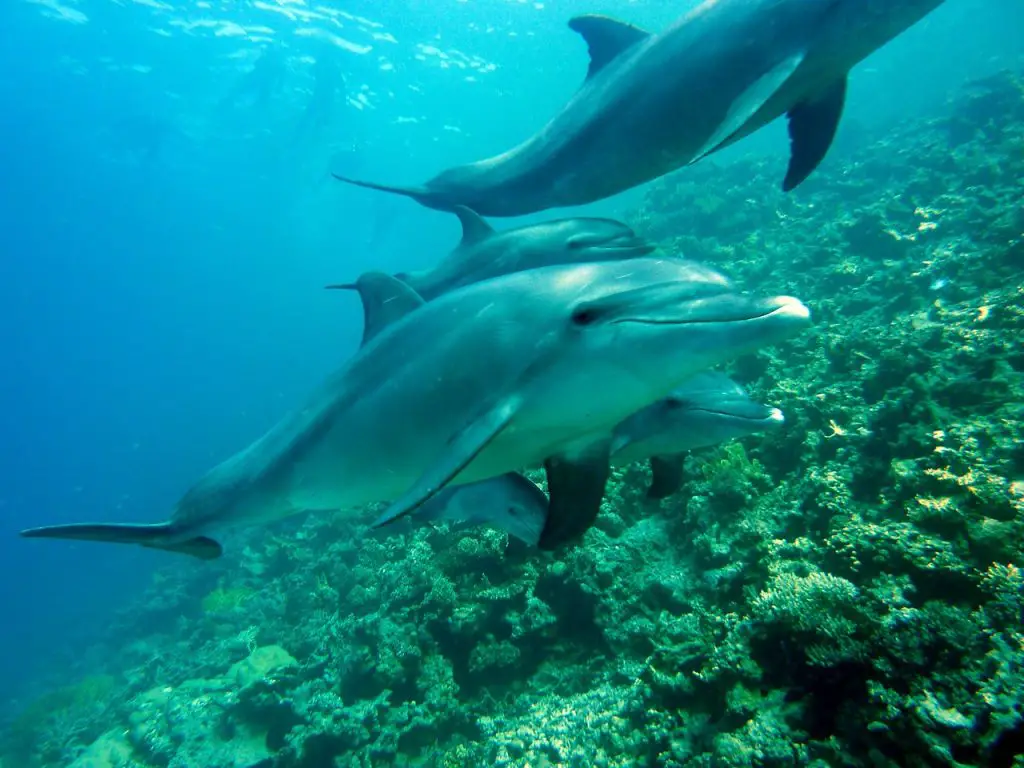
Bottlenose dolphins are charismatic inhabitants of Florida’s coastal waters. It’s not surprising that many nature lovers (including myself) were first enamored with dolphins, which drew them into wild places. With its sleek, gray body and distinctive “bottlenose” snout, it is instantly recognizable. Bottlenose dolphins are highly social creatures, often seen swimming in groups called pods, engaging in playful behaviors and cooperative hunting.
These intelligent creatures have evolved several adaptations to thrive in Florida’s aquatic environments. Their exceptional echolocation abilities allow them to navigate and locate prey, even in murky waters. They can reach speeds of up to 20 mph, making them agile hunters. Their streamlined bodies reduce drag, enhancing their swimming efficiency.
Coastal regions, such as the Gulf of Mexico and the Atlantic Ocean, are prime spots for dolphin-watching. Taking a boat tour or visiting marine sanctuaries like the Dolphin Research Center in the Florida Keys provides a chance to witness these captivating marine mammals up close.
Roseate Spoonbill
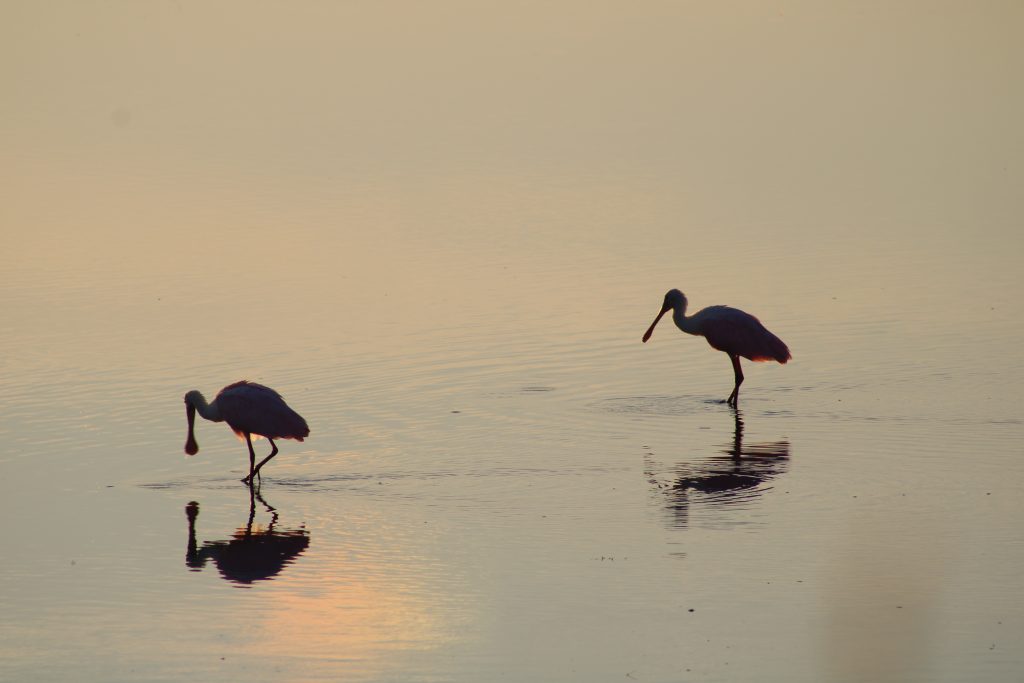
The roseate spoonbill (Platalea ajaja) adds a vibrant splash of pink to Florida’s wetlands. Sporting a distinctive rosy-pink plumage and a spoon-shaped bill, these birds are a sight to behold. Their striking appearance is further accentuated by their crimson eyes and long legs, making them an iconic symbol of Florida’s avian diversity.
Roseate spoonbills boast several unique adaptations that aid their survival in Florida’s marshy habitats. Their spoon-shaped bills are designed for efficient filter-feeding, allowing them to sift through shallow waters for crustaceans, insects, and small fish. Their bright pink coloration, a result of their diet rich in carotenoid pigments, helps them blend into their wetland surroundings.
Prime locations to observe Roseate Spoonbills include the Everglades, Big Cypress National Preserve, and various coastal estuaries and wetlands along both the Gulf of Mexico and the Atlantic coast. These birds often forage in shallow waters, making them relatively easy to spot. (I took the photo above in St. Marks National Wildlife Refuge)
Bald Eagle
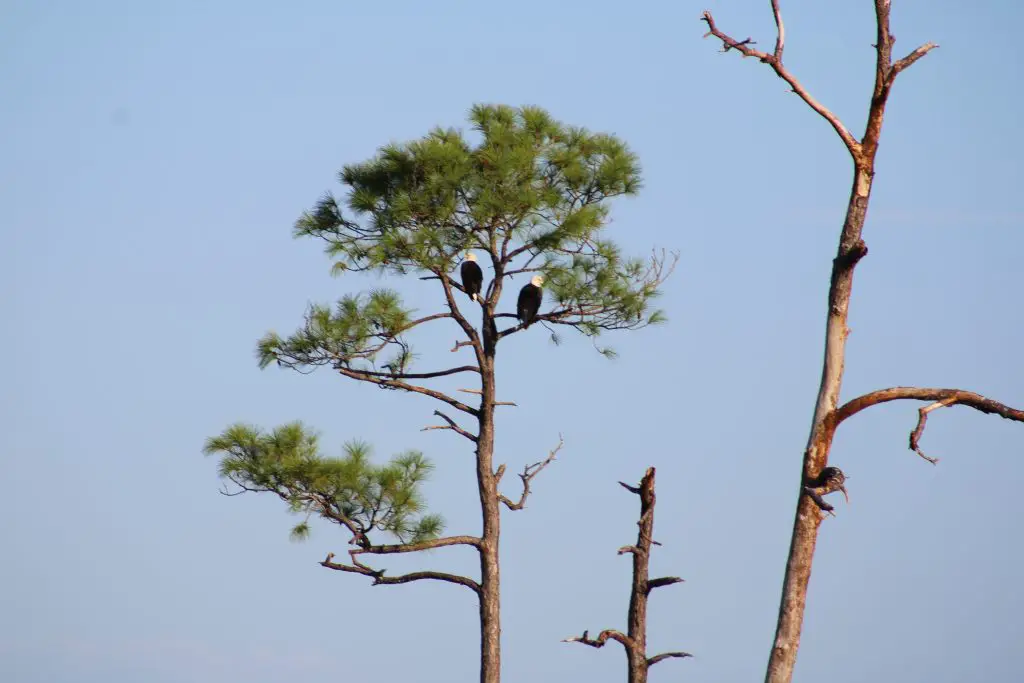
America’s national bird, is a majestic raptor that has found its home among Florida’s diverse ecosystems. With its striking white head and tail feathers, sharp yellow beak, and impressive wingspan of up to 7 feet, the bald eagle is a symbol of strength and freedom.
Bald eagles have several remarkable adaptations that enable their survival in Florida. Their keen eyesight allows them to spot prey from high in the sky, and their powerful talons ensure a firm grip on their catch. They are primarily fish-eaters, and Florida’s abundance of lakes, rivers, and coastal areas provide ample hunting grounds.
To witness the Bald Eagle in its natural habitat, you can visit several locations in Florida, including wildlife refuges, national parks, and along the state’s many water bodies. The St. Marks National Wildlife Refuge and the Everglades National Park are notable places for Bald Eagle sightings.
Gopher Tortoise
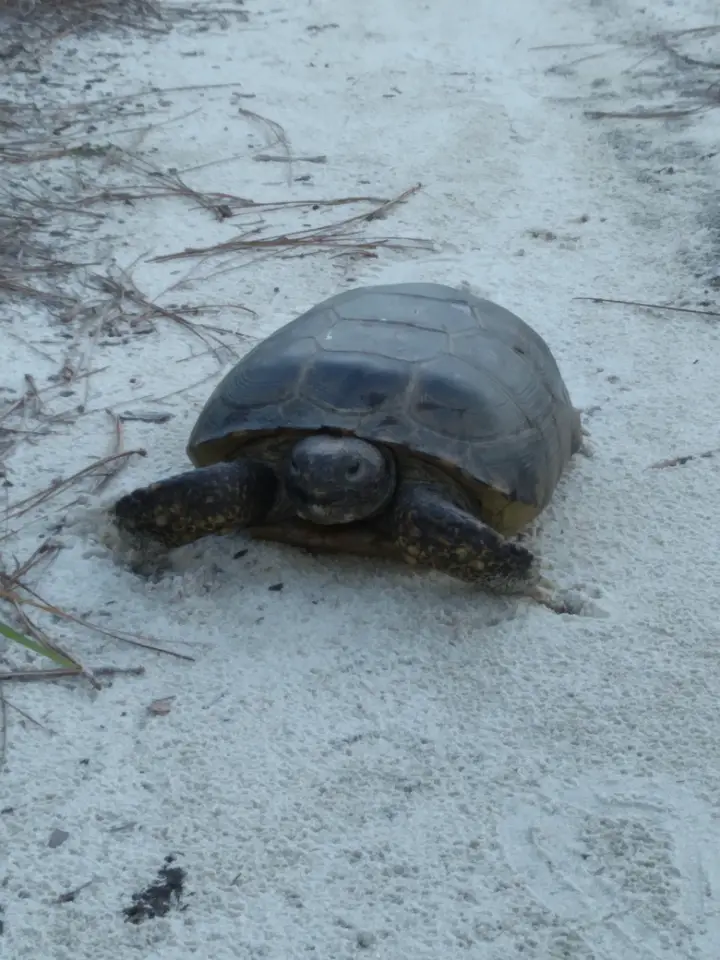
The Gopher Tortoise (Gopherus polyphemus), a keystone species in Florida’s ecosystems, is a terrestrial reptile known for its distinctive appearance and ecological significance. These tortoises possess a sturdy, domed carapace, with a brownish-gray coloration. Their forelimbs are adapted for digging, featuring strong, spade-like claws, which they use to excavate burrows.
One of the most remarkable adaptations of the Gopher Tortoise is its ability to dig extensive burrows. These burrows serve as refuge not only for the tortoises themselves but also for countless other wildlife species, making them an integral part of Florida’s ecosystem. Gopher Tortoises primarily feed on a diet of low-lying vegetation, including grasses and herbs, which they can find in abundance in Florida’s diverse habitats.
Encounters with Gopher Tortoises are relatively common in Florida, especially in pine flatwoods, sandhills, and scrubby habitats. They are known to inhabit various state parks and wildlife management areas, including the Ocala National Forest and the Apalachicola Bluffs and Ravines Preserve.
Black Bear
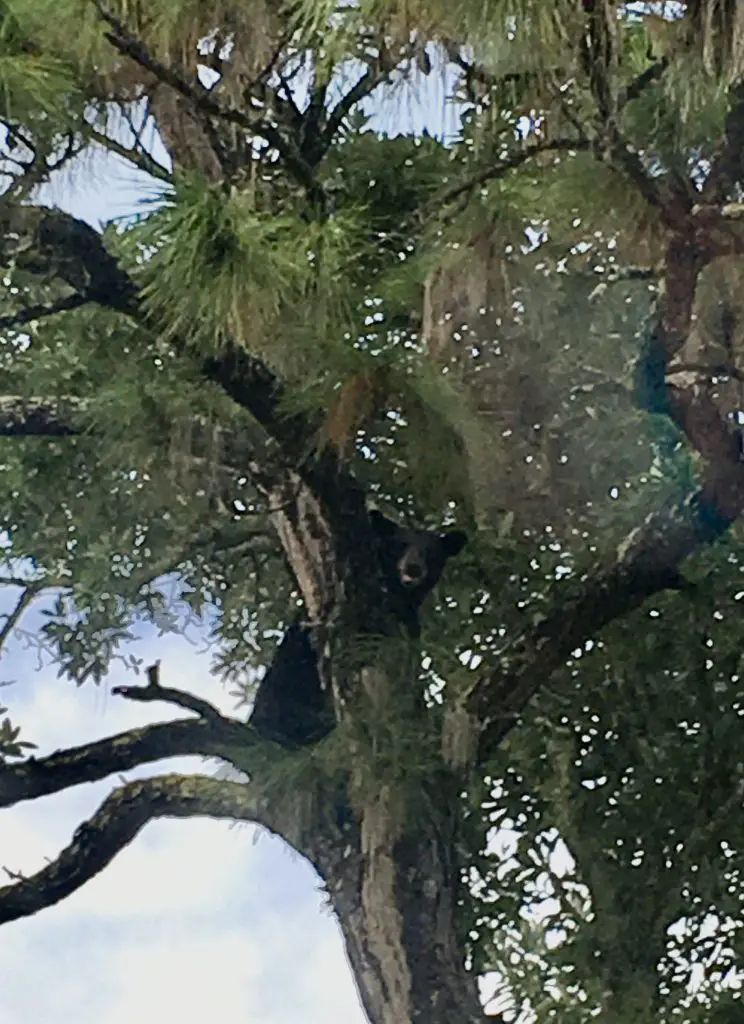
The Florida Black Bear (Ursus americanus floridanus), a subspecies of the American Black Bear, is an often misunderstood mammal that inhabits the wildlands of Florida. These bears are characterized by their solid black fur, although some individuals may display a brown or cinnamon hue. Florida Black Bears have a stocky build and stand about 3 to 5 feet tall at the shoulder.
Their keen sense of smell helps them locate food sources like berries, acorns, and plant matter. They are also strong climbers and swimmers, which proves useful when navigating the state’s forests, swamps, and wetlands.
Florida offers opportunities to spot these impressive mammals in various wildlife management areas and state parks, such as Ocala National Forest and Big Cypress National Preserve. The black bear’s extensive range in Florida includes both protected and urban areas, so bear encounters are possible, although respecting their space and following guidelines for coexistence is crucial.
I took the photo above in Carabelle, FL. (Near Apalachicola National Forest)
Florida Panther
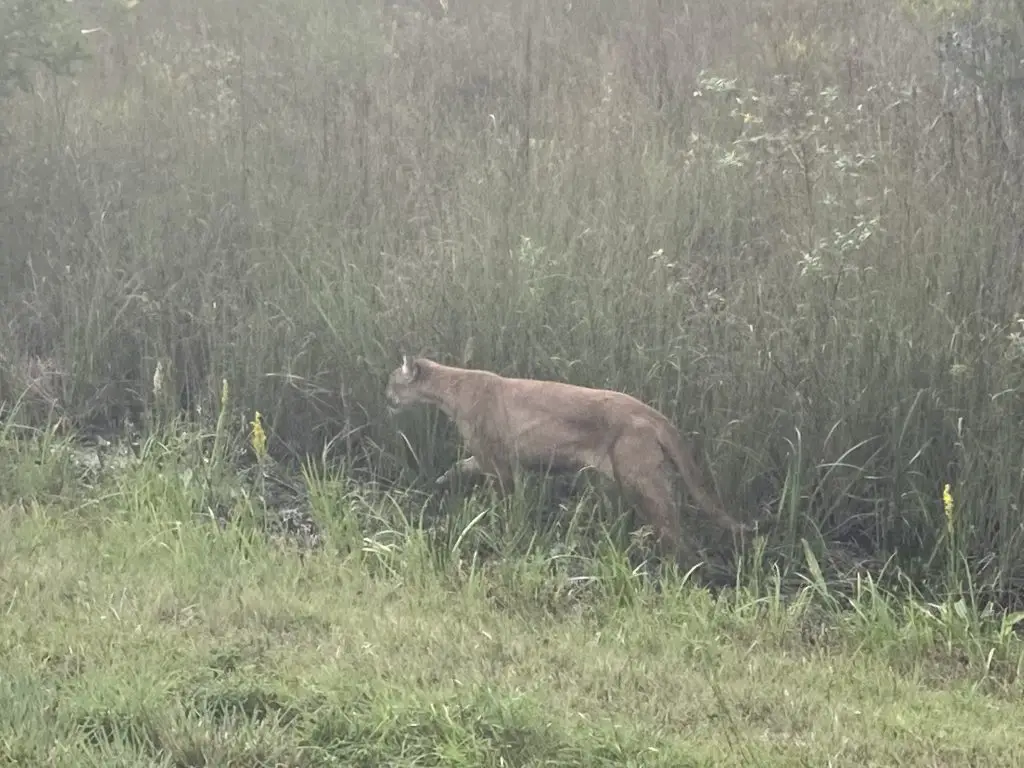
In terms of wildlife of Florida, it doesn’t get more iconic than the Florida Panther. The Florida Panther (Puma concolor coryi), a subspecies of the cougar, is an elusive big cat that prowls Florida. These panthers are characterized by their tawny fur, with a distinctively unmarked coat. They have powerful, sleek bodies, with long tails and prominent, round faces.
Florida Panthers have developed remarkable adaptations to thrive in Florida’s diverse ecosystems. Their sharp senses of hearing and sight aid them in hunting deer, raccoons, and other prey species. Strong, muscular limbs enable them to sprint at impressive speeds, making them skilled ambush predators. Their adaptability to various habitats, from swamps to pine forests, further contributes to their survival in Florida’s changing landscapes.
Spotting a Florida Panther in the wild is a rare and thrilling experience. You’ll have to be lucky to see one. I’ve only seen one after spending my entire childhood searching for one on long drives through their range. They can occasionally be seen in protected areas like Big Cypress National Preserve and Everglades National Park. However, due to their elusive nature and critically endangered status, these sightings are infrequent. If you see one, make sure to share your sighting with FWC for research purposes.
Burrowing Owl
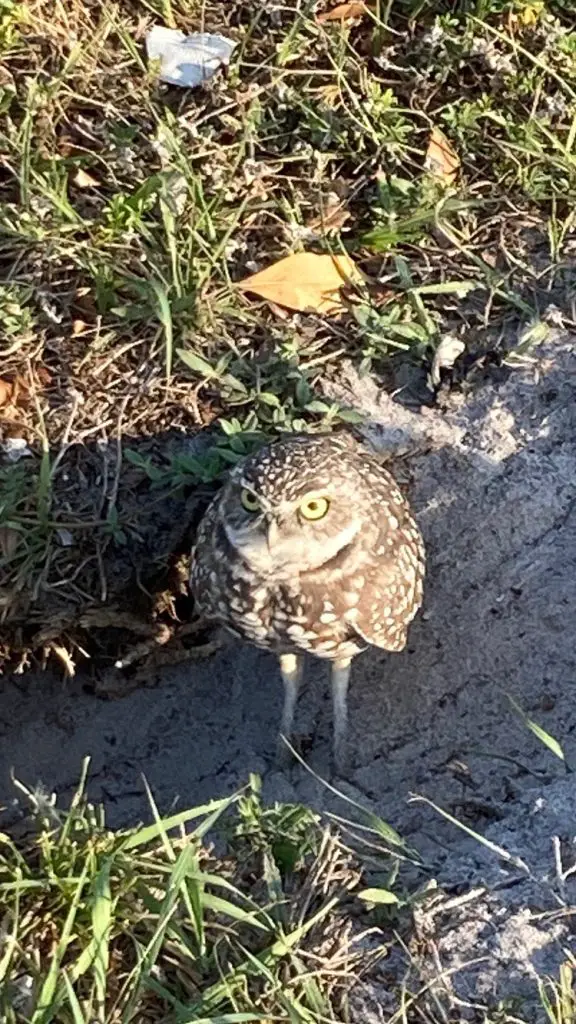
The burrowing owl (Athene cunicularia), a petite bird, is a resident of Florida’s open grasslands and sandy habitats. These owls are known for their diminutive size, measuring just 7 to 10 inches in height, and their striking appearance, marked by long legs and bright yellow eyes. They boast brownish-gray plumage, adorned with white speckles and distinctive barring.
Burrowing owls have evolved unique adaptations to thrive in Florida’s landscapes. They are ground-dwellers, utilizing burrows dug by mammals like gophers or tortoises, which they modify and occupy. This behavior provides them with shelter from predators and the hot Florida sun. Their keen vision and hunting skills make them efficient hunters of insects, small mammals, and occasionally small birds.
To observe these endearing owls in Florida, you can visit open grasslands, golf courses, or vacant lots, especially in areas like Cape Coral, which is known for its burrowing owl populations. Their habit of living near human development allows for relatively easy sightings.
Sandhill Crane
The Sandhill crane (Antigone canadensis) is a graceful bird that seasonally lives in Florida’s wetlands and grassy habitats. These cranes are recognized by their tall, slender stature, standing up to 4 feet tall, with grayish plumage and distinctive red crowns on their heads. They are known for their resonant calls, often heard during their distinctive courtship dances.
Sandhill cranes have long legs, which are ideal for wading in shallow waters, where they feed on aquatic plants, insects, and small vertebrates. Their keen eyesight and hearing help them detect potential predators, while their social behavior, including communal roosting, provides added protection.
For those eager to witness the beauty of Sandhill Cranes, Florida offers numerous opportunities. Wetlands, marshes, and open grasslands are prime habitats to spot these birds. Paynes Prairie Preserve State Park, Myakka River State Park, and the Orlando Wetlands Park are excellent locations to observe Sandhill Cranes.
Flamingo
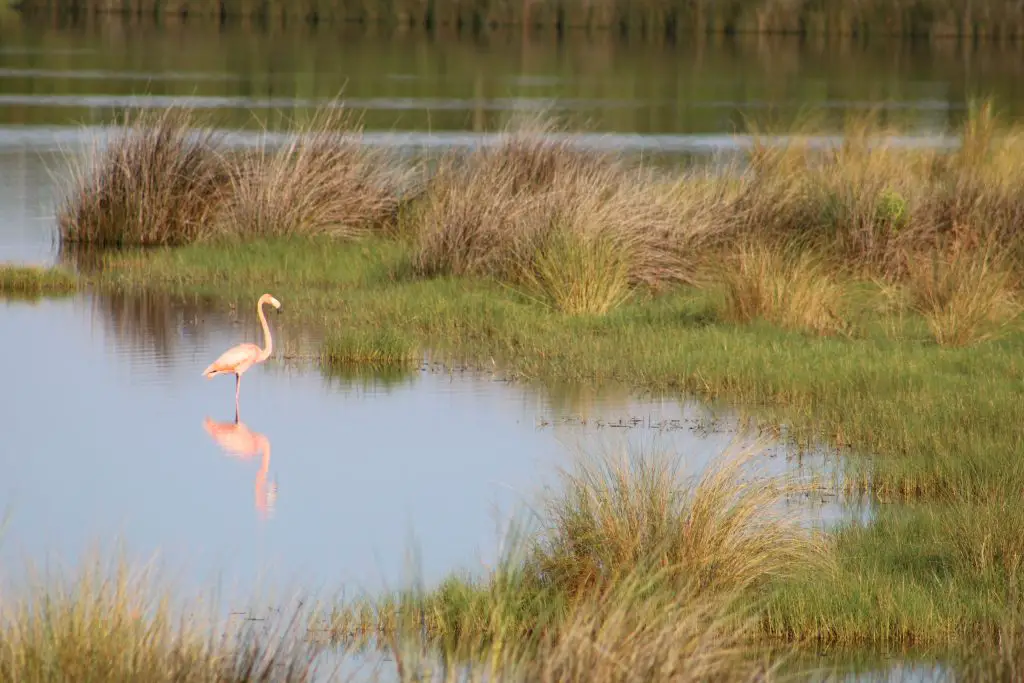
Flamingos seem to be synonymous with beach rentals on every coast in Florida. But the reality is that flamingos are a relatively rare sight in the state.
Their long legs allow them to wade effortlessly in shallow waters, where they feed on aquatic organisms like algae, small fish, and crustaceans. The striking pink coloration of their feathers is a result of their diet rich in carotenoid pigments. This coloration not only serves as camouflage in their wetland surroundings but also provides protection against harmful UV rays.
While sightings of American Flamingos in Florida are relatively uncommon, these birds can occasionally be spotted in coastal areas, estuaries, and shallow wetlands, particularly in the southernmost regions of the state.
American Crocodile
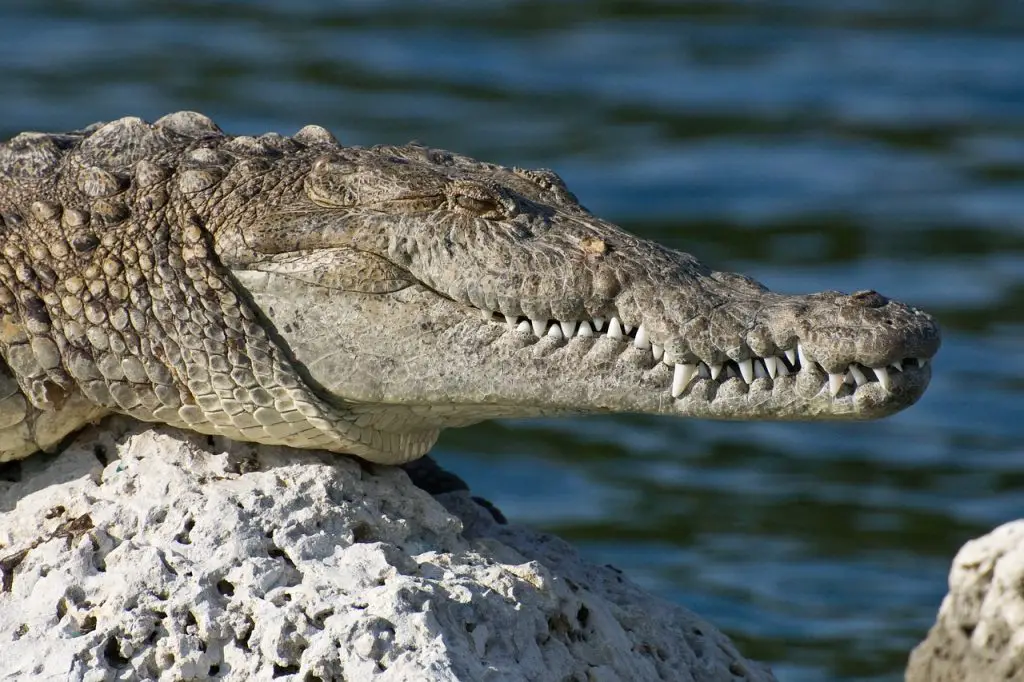
The American Crocodile (Crocodylus acutus), a formidable and semi-aquatic reptile, lives in Florida’s coastal and brackish waters. These crocodiles possess a robust, armored body with grayish-green to olive-brown scales. They are characterized by their V-shaped snout, which distinguishes them from the more pointed snout of alligators.
Their powerful jaws are designed for capturing prey, primarily fish and small mammals, and their excellent swimming abilities enable them to navigate both freshwater and saltwater habitats. They also have specialized salt glands that allow them to excrete excess salt, enabling them to inhabit brackish and saltwater environments.
While encounters with American Crocodiles in Florida are less common than with alligators, they can be seen in various coastal areas, estuaries, and mangrove swamps, particularly in the southern regions of the state. Crocodile Lake National Wildlife Refuge in Key Largo is one of the protected areas where they are occasionally observed.
Coyotes
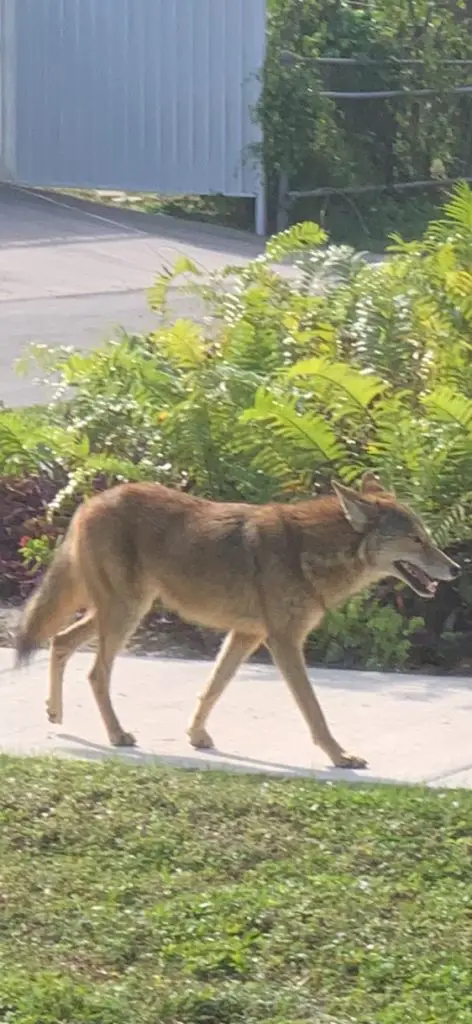
Coyotes are resourceful and adaptable canids that live across multiple habitats in Florida. These medium-sized mammals typically exhibit a grayish-brown coat, though variations in coloration can occur. Coyotes have a slender build, erect ears, and a bushy tail. Their physical appearance often leads to occasional confusion with domestic dogs.
Coyotes possess a keen sense of smell and excellent night vision make them effective hunters of small mammals, birds, and even plant matter. They have a wide-ranging diet, which includes fruits, insects, and carrion, allowing them to exploit various food sources. Their ability to live in a range of habitats, from forests and swamps to urban areas, underscores their adaptability.
Coyotes are highly adaptable and have been observed in many parts of Florida. They can thrive in both rural and urban settings, making sightings possible in various locations throughout the state. I’ve even seen one marching down the street in a densely populated South Florida city.
Bobcats
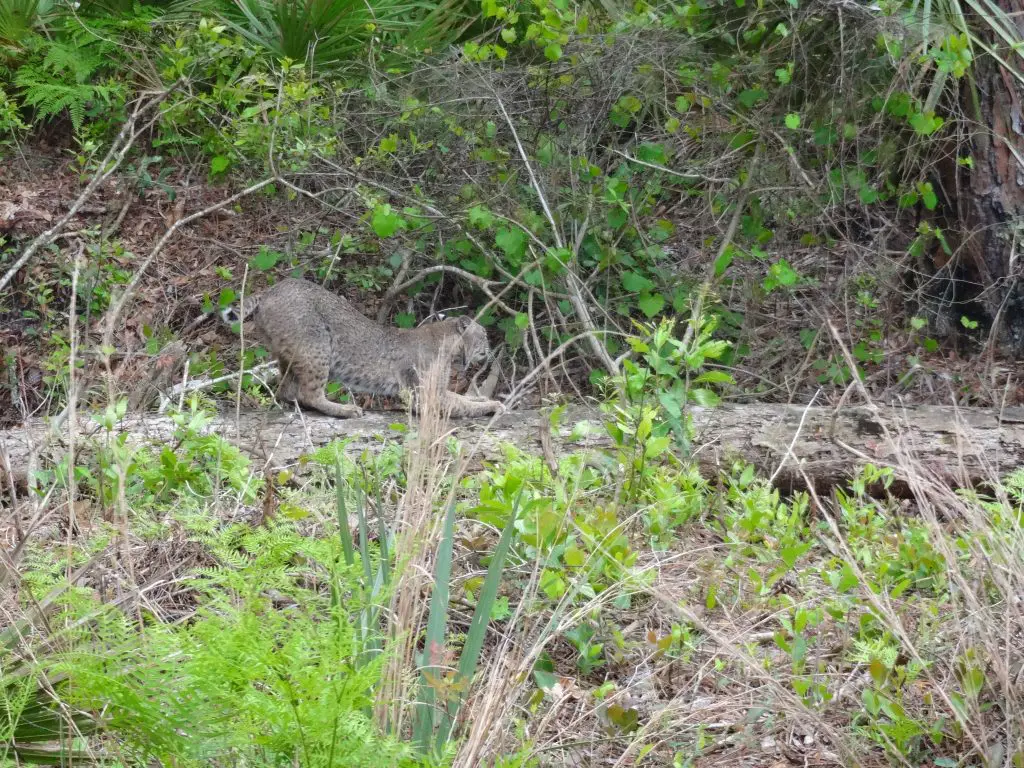
Bobcats are secretive felines that live in the shadows of Florida. The cats have compact, medium-sized bodies with a distinctive spotted coat that ranges from tawny to grayish-brown, accented by dark spots and stripes. Bobcats have tufted ears, a short tail, and keen, yellow eyes that enable them to be skilled hunters.
Bobcats are solitary and elusive creatures, often active during the twilight hours and nighttime. Their sharp claws and powerful limbs make them agile climbers and proficient hunters of small mammals, birds, and even deer. Their keen sense of smell and acute hearing further enhance their hunting capabilities.
Encounters with Bobcats in Florida are relatively rare due to their elusive nature, but they can be found in a variety of habitats, including forests, swamps, and even suburban areas. Protected natural areas such as the Big Cypress National Preserve and the Ocala National Forest offer opportunities to catch glimpses of these enigmatic felines.
Bull Shark
The bull shark (Carcharhinus leucas), a formidable and highly adaptable predator, is a prominent inhabitant of Florida’s coastal waters. These sharks are known for their stocky, muscular bodies, ranging from gray to bronze in color. They have a distinctive blunt snout and small, sharp teeth, perfect for grasping prey.
Bull sharks are known for their tolerance to a wide range of salinities, allowing them to thrive in both freshwater and saltwater environments, including rivers, estuaries, and coastal areas. Their exceptional ability to regulate salt levels in their bodies helps them navigate these varied habitats. Bull Sharks are also opportunistic feeders, with a diet that includes fish, rays, turtles, and even other sharks.
To encounter bull sharks in Florida, you can visit various coastal regions, including the Atlantic and Gulf coasts. These sharks are often present in waters near river mouths and estuaries, and divers and snorkelers may have the opportunity to see them in their natural habitat.
Largemouth Bass
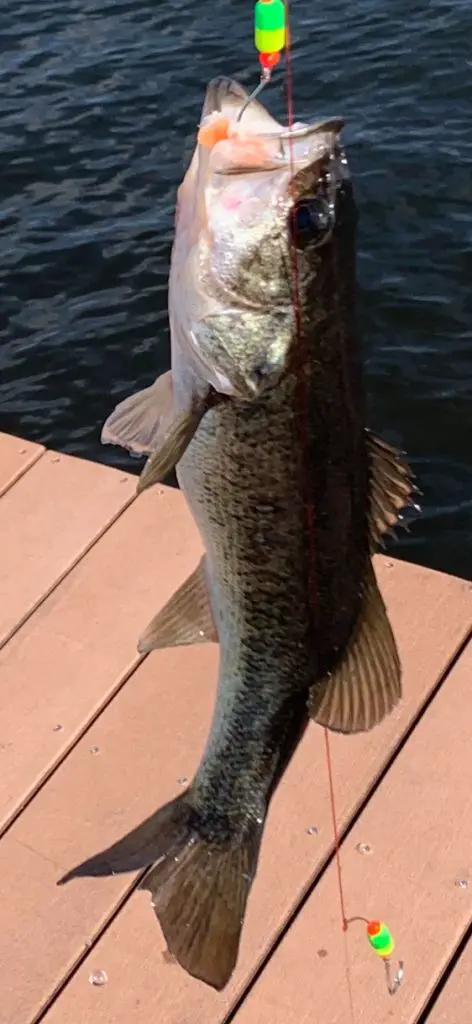
Largemouth bass are prized sportfish and iconic freshwater inhabitants of the state. These bass are known for their distinctive appearance, featuring a large mouth that extends beyond the back of the eye, a greenish-gray body with a lateral line, and a prominent dark lateral stripe.
Their sizeable mouths allow them to engulf a wide range of prey, including fish, insects, and even small birds. They are often ambush predators, lurking in submerged vegetation or near structures to surprise their prey. Their ability to tolerate varying water conditions, from clear lakes to murky swamps, is another key adaptation that contributes to their survival.
Anglers and nature enthusiasts have ample opportunities to see and interact with Largemouth Bass in Florida’s numerous lakes, rivers, and reservoirs. Popular fishing destinations include Lake Okeechobee, the St. Johns River, and the Everglades.
Sailfish
Sailfish have a striking appearance, featuring a long, pointed bill and a large dorsal fin that resembles a sail. They have a sleek, silver-blue body adorned with iridescent hues, making them a spectacular sight when caught in the Florida sun.
Sailfish have evolved remarkable adaptations to thrive in Florida’s offshore environments. Their elongated bills and impressive speed make them effective hunters of smaller fish, including schools of sardines and anchovies. They are known for their distinctive “sail-up” behavior when hunting, corralling prey to the surface and then striking with precision. Their incredible swimming abilities and agility in the water allow them to navigate the vast ocean expanses off Florida’s coast.
For those seeking to witness Sailfish in action, Florida’s Atlantic coast, particularly off the shores of locations like Miami, Fort Lauderdale, and the Florida Keys, offers some of the best opportunities. Charter fishing trips are a popular way to experience the thrill of catching and releasing these magnificent creatures.
Mockingbird
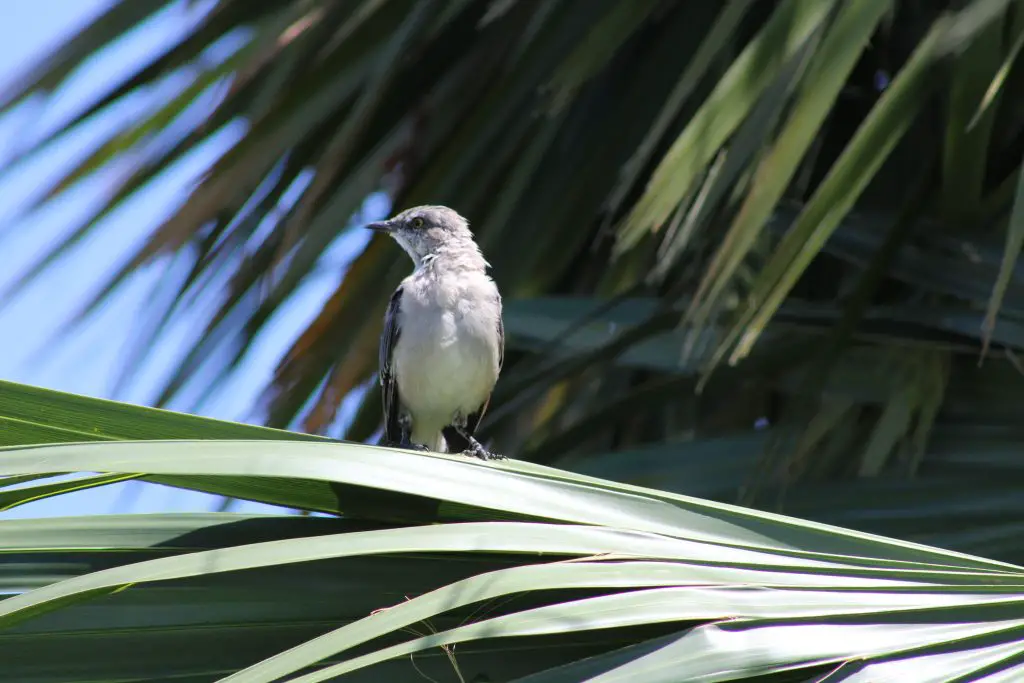
Mockingbirds are the state bird of Florida. The versatile and melodious songbird lives across Florida’s urban and suburban landscapes. Their omnivorous diet, which includes insects, fruits, and berries, allows them to exploit diverse food sources found in both natural and human-altered environments.
Northern Mockingbirds are prevalent as wildlife in Florida. You can usually see them in residential areas, parks, and gardens. Their habit of singing from elevated perches, such as treetops and utility lines, often makes them visible and audible to people in both urban and rural settings.
Pelican
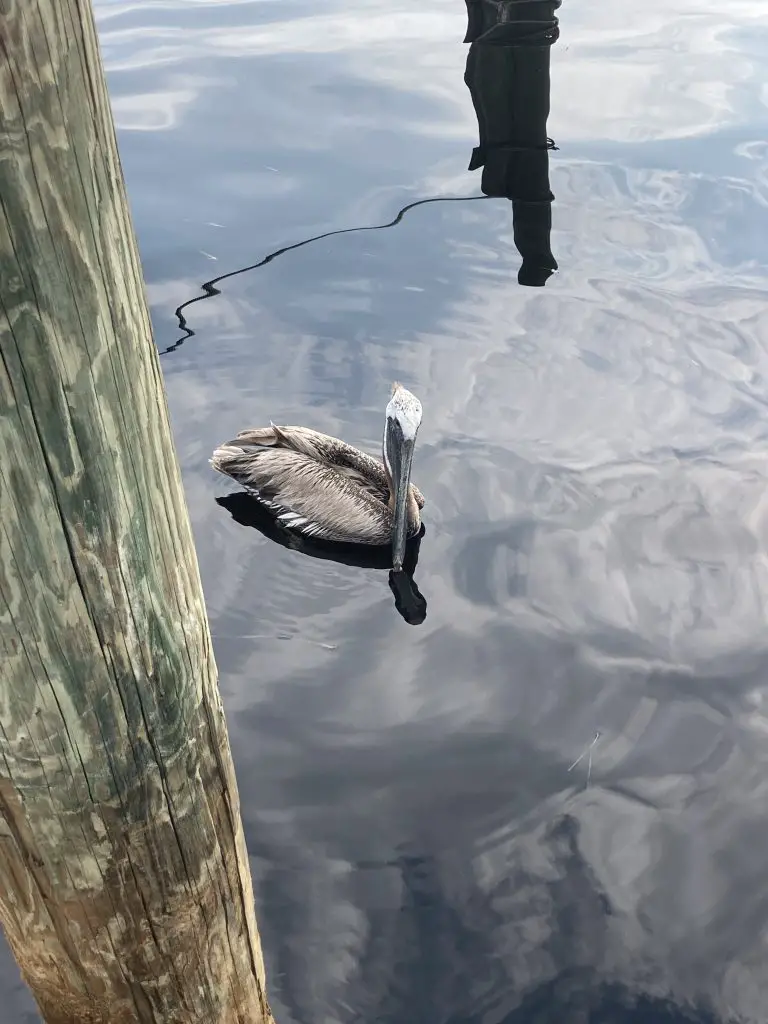
The brown pelican (Pelecanus occidentalis) is a highly visible resident of Florida’s shoreline and estuarine habitats. These pelicans are known for their large size, long bills, and characteristic pouches that they use for catching and storing fish. They have a brownish-gray body with a white head and neck during their breeding season, while their non-breeding plumage displays a darker, brownish hue.
Brown pelicans have an impressive wingspan and soaring flight, which enables them to cover vast distances while searching for schools of fish to dive upon. Their long bills and expandable throat pouches are perfectly suited for efficient fishing, allowing them to scoop up prey from the water’s surface. Their keen eyesight aids them in spotting fish from high above the waves.
To witness this type of wildlife in Florida, visit coastal areas, including beaches, bays, and estuaries along both the Atlantic and Gulf coasts. You can usually spot these birds gliding over the water or diving spectacularly to catch fish.
Fox Squirrel
The Fox Squirrel (Sciurus niger) is a charismatic and larger cousin to the common gray squirrel that can be found in Florida’s forests and woodlands. These squirrels are distinguished by their substantial size, with a body length of up to 15 inches and a luxurious, bushy tail. They have a rust-colored coat with striking variations, such as silver-gray or black fur.
Fox Squirrels have strong, sharp claws that are ideal for climbing trees and navigating branches, while their keen sense of smell and excellent vision help them locate food sources like nuts, seeds, and fruits. Their ability to leap gracefully from tree to tree, combined with their swift ground movement, makes them adept at escaping predators.
To observe Fox Squirrels in Florida, you can explore wooded areas, parks, and forests throughout the state. You can spot them foraging for food or scampering among the trees, particularly in habitats rich in oak and pine trees. For example, I see them regularly in Apalachicola National Forest.
Great Blue Heron
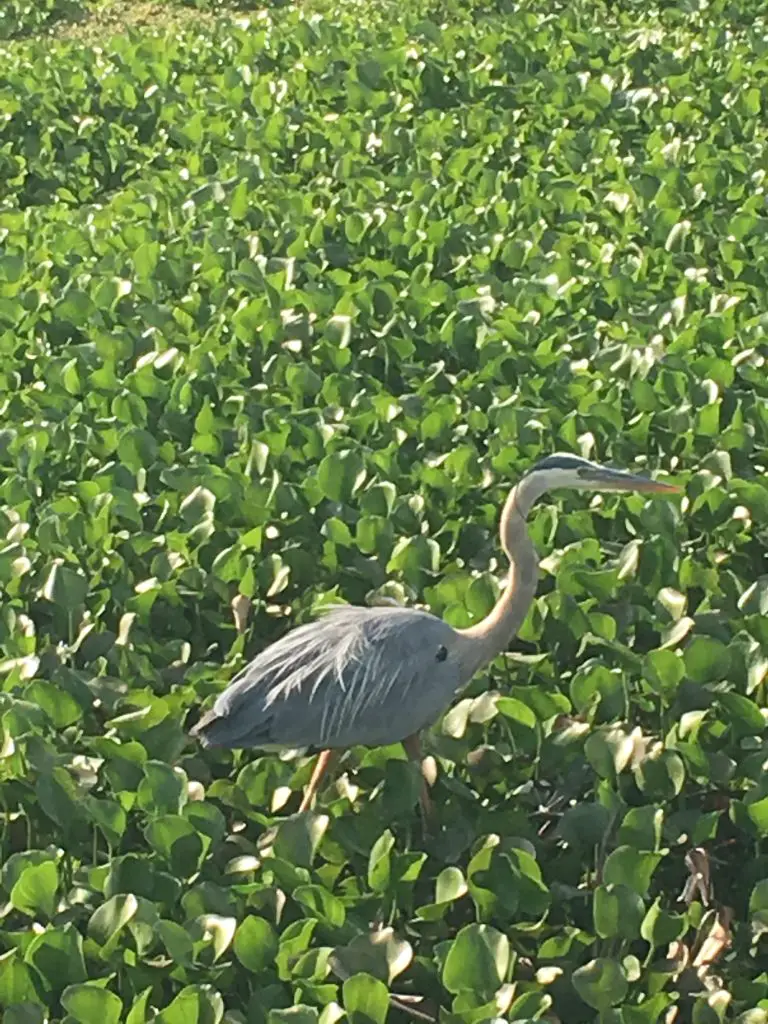
The Great Blue Heron (Ardea herodias) is an elegant wader that lives in Florida’s wetlands, marshes, and coastal habitats. These herons stand up to 4.5 feet tall with a wingspan of nearly 6 feet. They have a striking appearance, featuring a blue-gray body, a long, sinuous neck, and a dagger-like bill that aids in catching prey.
Great Blue Herons have developed several adaptations that make them formidable hunters in Florida’s watery realms. Their slow, deliberate movements allow them to stalk fish, amphibians, and other aquatic creatures with precision. Their sharp beaks are well-suited for capturing a wide variety of prey. Additionally, they have excellent vision and can spot potential meals from considerable distances.
To observe Great Blue Herons in Florida, head to a wetland or coastal area. These herons often wade in shallow waters or perch patiently along the shorelines, making them accessible to wildlife enthusiasts and birdwatchers.
Shinyrayed Pocketbook
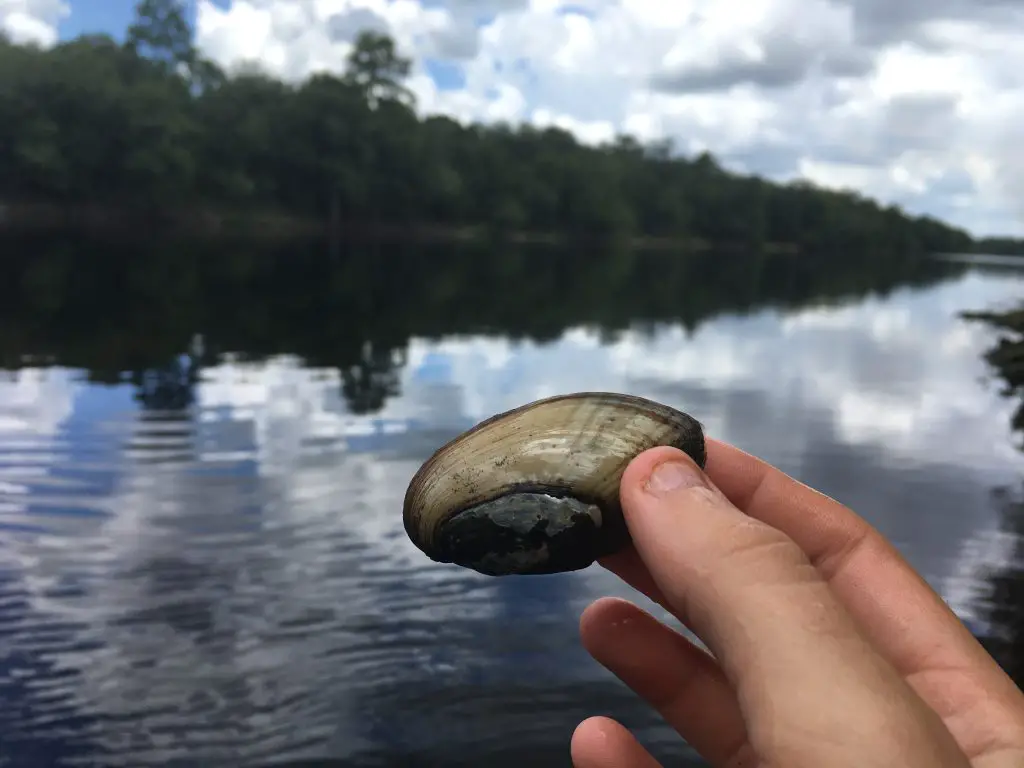
The shinyrayed pocketbook (Hamiota subangulata) is an exquisite and freshwater bivalve mollusk. Although lesser-known, this mussel fits within the diverse wildlife of Florida. These mussels have their distinctive, elongated shells, which are often marked with fine, radiating lines or “rays.” The shell’s surface can vary in color from brown to greenish-yellow.
Shinyrayed pocketbooks play a vital role in Florida’s waterways by helping to filter and purify the aquatic environment. They feed on microscopic organisms, algae, and organic particles by filtering water through their gills. This filtration process not only contributes to water quality but also benefits other aquatic life.
Encounters with shinyrayed pocketbooks are less common than with some other wildlife species. These mussels inhabit freshwater streams, rivers, and lakes in various parts of Florida. While not often seen directly, their presence is an indicator of healthy aquatic ecosystems.
White Ibis
The White ibis (Eudocimus albus) is a common and beloved wading bird of Florida’s wetlands, marshes, and coastal areas. These ibises have striking all-white plumage, long, slender legs, and curved bills that are often orange or pinkish. During the breeding season, adults display bright red skin on their faces and bills.
White ibises have long, curved bills. They use these for probing mud and shallow water to capture aquatic invertebrates, small fish, and crustaceans. Their social nature and foraging in groups allow them to maximize food resources, making them efficient hunters. Their preference for both freshwater and saltwater habitats makes them adaptable to various wetland environments.
Tri-Colored Heron
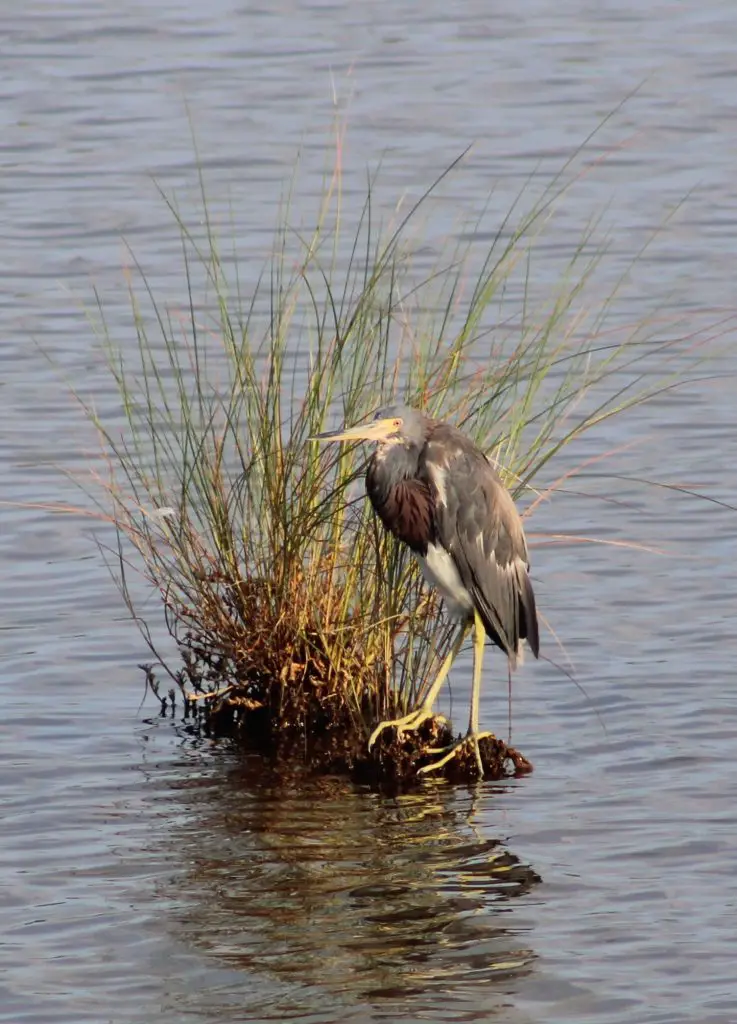
The tricolored heron (Egretta tricolor) is a wading bird that graces the wetlands of Florida. Recognizable by its striking plumage, it features blue-gray feathers on its body, a purple-maroon neck, and a white line along its throat. With a slender build and a distinctive long, pointed bill, tricolored herons exhibit elegance in both appearance and movement.
Noteworthy is their foraging technique—tricolored herons are known for their dynamic hunting behavior. They employ a series of quick movements, including darting forward, spreading their wings, and using their feet to stir up prey in shallow waters. This active and engaging hunting style makes them a captivating species for birdwatchers and nature enthusiasts.
River Otter
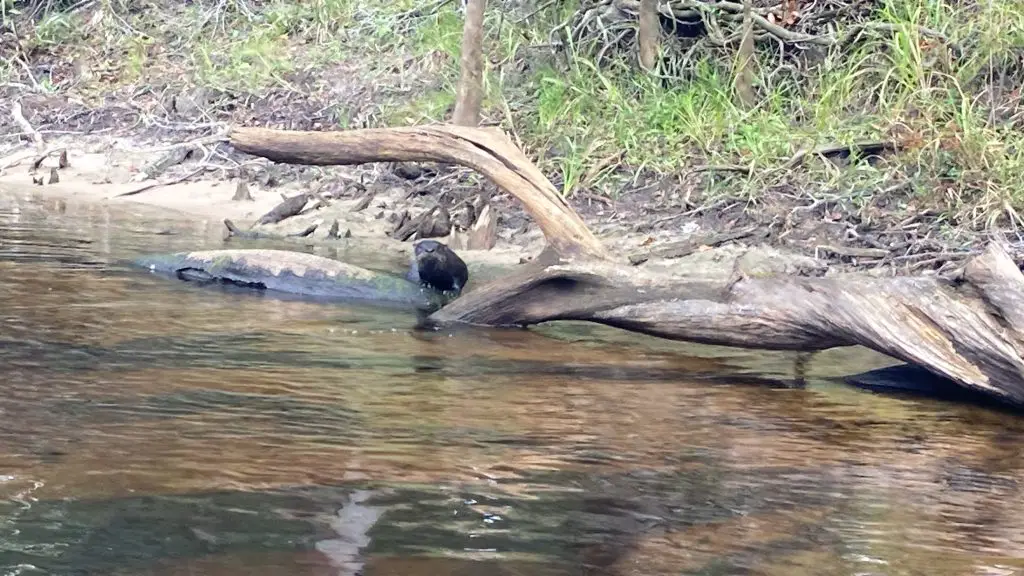
I’ve been lucky enough to see river otters several times on rivers in Florida. The picture above is from the Santa Fe River, where I saw an adorable family of river otters.
The river otter (Lontra canadensis) is a charismatic and highly adaptable mammal that calls the waterways of Florida home. With a sleek, streamlined body and a luxurious brown coat, these otters exhibit remarkable swimming prowess. Their webbed feet and long, tapered tail contribute to their agility in the water, making them skilled hunters of fish, amphibians, and invertebrates.
Monarch Butterflies
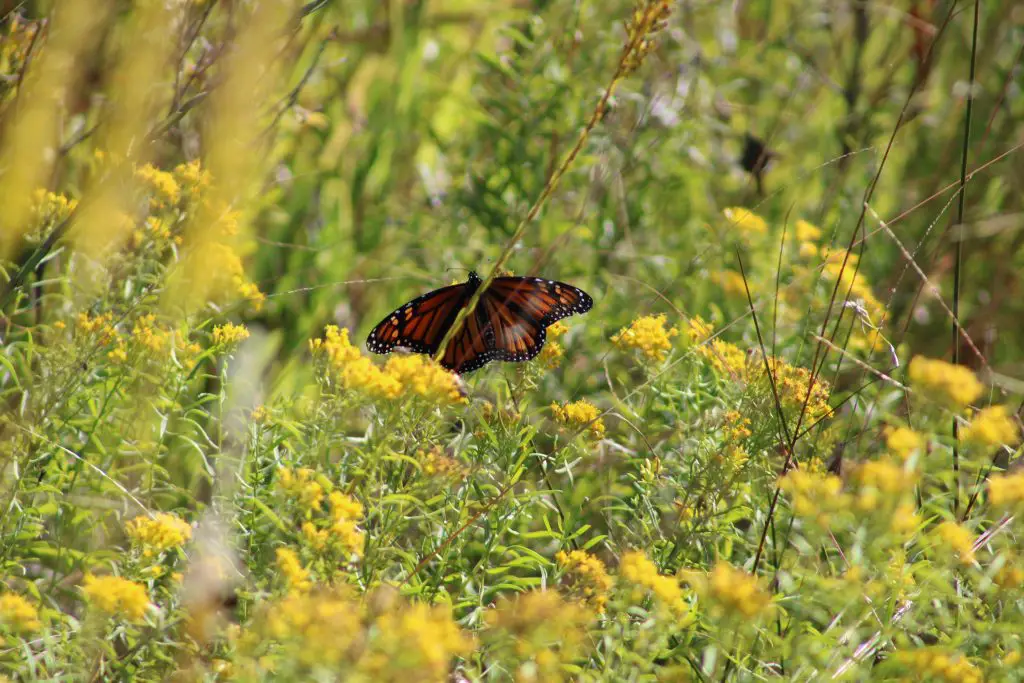
The monarch butterfly (Danaus plexippus) graces the skies of Florida with its iconic orange and black wings, captivating both scientists and nature enthusiasts alike. With a wingspan ranging from 3.7 to 4.1 inches, these butterflies embark on an extraordinary migration journey, covering thousands of miles from their breeding grounds in North America to their wintering grounds in Mexico.
I love to seek out monarchs on their annual migration. Near my home in North Florida, I’m able to see hundreds of these beautiful butterflies in the fall at the St. Mark’s Wildlife Refuge.
The Bottom Line on Wildlife of Florida
Wildlife of Florida represents a beautiful swath of animals. The animals on this list are just a sample of the creatures you can see in the state. But these iconic animals might be what makes you want to visit the Sunshine State.